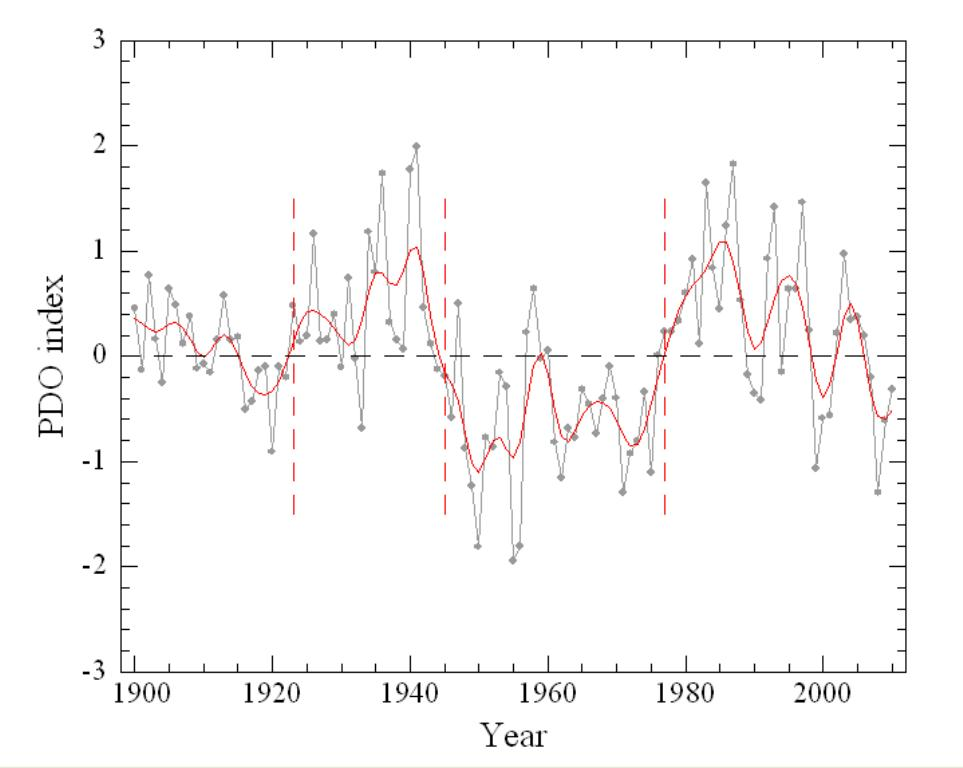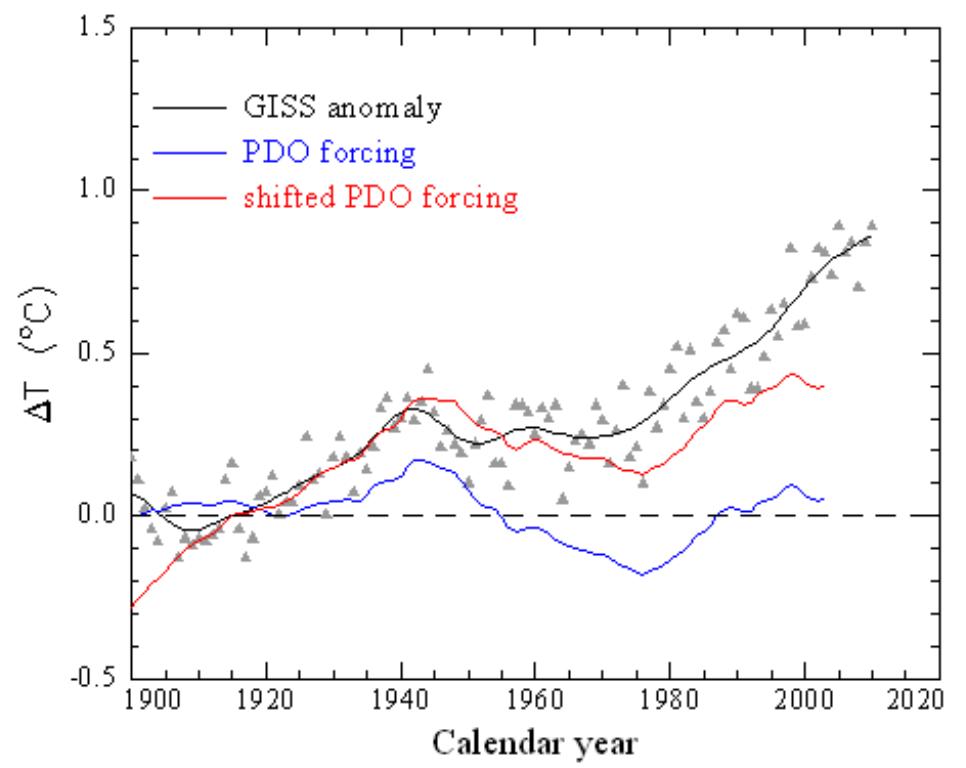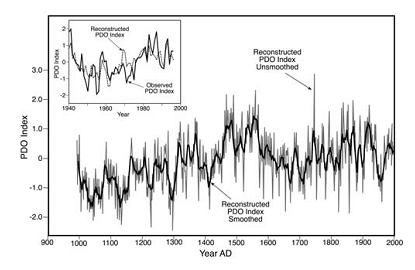The Pacific Decadal Oscillation (PDO) is not causing global warming
What the science says...
| Select a level... |
 Basic
Basic
|
 Intermediate
Intermediate
|
 Advanced
Advanced
| ||||
|
The PDO is an oscillation with no trend. It moves the heat through different part of the climate system but can not create nor retain heat. It can not be the cause of a long term warming trend. |
|||||||
It's Pacific Decadal Oscillation
"The Pacific Decadal Oscillation (PDO) is a temperature pattern in the Pacific Ocean that spends roughly 20-30 years in the cool phase or the warm phase. In 1905, PDO switched to a warm phase. In 1946, PDO switched to a cool phase. In 1977, PDO switched to a warm phase. In 1998, PDO showed a few cool years. Note that the cool phases seem to coincide with the periods of cooling (1946-1977) and the warm phases seem to coincide with periods of warming (1905-1946, 1977-1998)." (The Reference Frame)
The Pacific Decadal Oscillation (PDO) has gained some traction as an alternative hypothesis as the cause of the last century warming or at least a good part of it. More often, this hypothesis is based on the apparent visual correlation between warming periods and the positive phase of the PDO, but others ventured in semi-quantitative analysis (e.g. Dr. Roy Spencer).
Although none of them can be called strong evidence, it's worth looking at this climate feature in more details, obviously starting from describing it. The first thing to note is that the PDO, like any other oscillation, can not be the cause any long term trend. Whatever the impact of one phase might be, the opposite phase would have the opposite effect and after a full cycle the system would be brought back to where it was at the beginning. The heat can just be moved around through different parts of the system and it may even be "hidden" for some time, but after a full cycle it will be back. In other words, an oscillation does not create nor retain heat and we cannot have both an air and ocean long term warming trend.
The Pacific Decadal Oscillation
The PDO is a pattern of climate variability of the North Pacific (north of 20°) with period around 60 years. It's characterized by a positive (warm) phase with an anomalously cold central-western Pacific sea surface temperature (SST) and a warm eastern pacific SST. The opposite applies for the negative (cold) phase. Note that the terms "warm" and "cold" are definitely USA-centric.

Fig. 1: Typical wintertime Sea Surface Temperature (colors), Sea Level Pressure (contours) and surface windstress (arrows) anomaly patterns during warm and cool phases of PDO. Left panel: positive (warm) phase; right panel: negative (cold) phase. (from JISAO).
Although the PDO may vary from year to year, it shows a tendency to be either in the positive or in the negative phase. To summarize its behaviour with time, the PDO index is derived as
[...] the leading PC of monthly SST anomalies in the North Pacific Ocean, poleward of 20N. The monthly mean global average SST anomalies are removed to separate this pattern of variability from any "global warming" signal that may be present in the data.
In other words, given a spatial pattern, this index describes how it changes with time. It is important to note that the "monthly mean global average SST anomalies are removed"; hence this index actually describes the "anomalous anomaly" of the North Pacific with respect to the global ocean.

Fig. 2: annual PDO index from 1900 to 2010 (grey line). The red line is a 5 year smoothed version. Vertical dashed lines represent the three regime shifts (see text).
Three so-called regime shifts can be seen in the PDO index shown in fig 2, namely around 1923, 1945 and 1977. In particular, from the PDO index we see that between 1945 and 1977 the global ocean has warmed more than the North Pacific; this is the reason why some skeptics think that the PDO pushed the brakes on global warming.
The process to separate variability from the global warming signal implicitly assumes that the SST response to global warming is spatially uniform. This looks quite unlikely and we should expect the global warming signal to "leak" into the PDO index (Bonfils et al 2010). This fact alone should make the alarm bell ring before using it to explain global warming or even to remove the natural variability associated with PDO from observational datasets.
The causes of the PDO
It should be clear that in a strongly coupled system like our climate, nothing happens in isolation or by itself. Although a definitive answer to the question of what causes the PDO cannot be given, several studies have shown that the PDO depends on other climatic factors.
Some of you may have noticed that the PDO patterns shown in fig. 1 somewhat resemble the ENSO pattern (here in the positive phase); indeed, the PDO can be described as a long-lived ENSO-like pattern. Newman et al. 2003 have found that the PDO can be modelled as a first-order autoregressive process driven by ENSO. To make it simple, we may say that the PDO is atmospheric "noise" interacting with ENSO. Even more important, Shakun et al. 2009 obtained similar results regressing separately over the North and South Pacific. This means that the PDO is part of a more general pacific decadal variability driven by ENSO.
Schneider et al 2005 added to the picture the Aleutian low variability and the ocean circulation along the Kuroshio–Oyashio Extension (the Western Pacific counterpart of the Gulf Stream in the Atlantic Ocean). They conclude that the PDO is "a response to changes of the North Pacific atmosphere resulting from its intrinsic variability, remote forcing by ENSO and other processes, and oceanwave processes associated with ENSO and the adjustment of the North Pacific Ocean by Rossby waves".
Thus, the PDO is a response to something else; treating it as a forcing must be taken with caution.
The impact of PDO on global temperature
As noted before, some skeptics claim that the PDO is responsible for the 20th century temperature trend. Prominently, Roy Spencer used a simple energy balance model (EBM) forced by "cloud cover variations directly proportional to the PDO index values" to show that indeed much of the warming can be accounted for by the PDO alone. A zero-dimensional EBM relates the temperature change with the energy imbalance of the earth; mathematically, it can be written as
![]()
where C is the heat capacity, λ the climate sensitivity and F(t) the forcing; it can be shown that the response time of the system is given by τ = C λ .
In his post Spencer does not give many details on what he did. In particular he says that he "ran many thousands of combinations" with varying parameters and that his graph shows "an average of all of the simulations that came close to the observed temperature record"; a bit mysterious and hard to reproduce. Though, he gives an average value of the parameters: 800 m for the ocean mixing depth, λ = 0.33 °C/Wm-2 and a proportionality factor between the PDO index and forcing of 1.7-2.0 W/m-2. With these numbers it's possible to calculate ΔT from the equation above; the result is shown in the figure below as blue line.

Fig. 3: triangles: GISS anomaly baselined 1900-1920; the black line is a 11-years smoothed version. Blu line: ΔT calculated from the PDO index. Red line: the same as the blue line but with a shifted PDO index.
It's evident that the calculated curve does not follow the measured ΔT much nor it is anything like Spencer's curve. Indeed it couldn't, it behaves exactly as expected given that the PDO index has no trend. The question is, then, how to reproduce Spencer's result. Answering this question requires a sort of "reverse engineering", which is prone to result in the wrong answer; nevertheless, I tried. Using the same parameters as before but shifting the PDO forcing up by about 2 W/m2, i.e. assuming an initial imbalance that large, I obtained the red curve shown in fig. 3 which this time looks pretty much like Spencer's curve.
(Note: you might want to read a similar and more authoritative explanation on how to cook a graph or Barry Bickmore's take).
If true, this is equivalent to adding a background linear temperature trend. In the end, contrary to Spencer's claim we can rule out at least that the PDO alone can explain the last century warming trend.
The PDO in the past
There has been some reconstructions of the PDO in the past. Clearly, there are no measurements available and it's also hard to find reliable proxies of the sea surface temperature in the North Pacific. Typically precipitation sensitive proxies are used.
Bondi et al. 2001, for example, used tree rings for the period from 1660 to 1992 from trees collected between Southern California and northern Baja California, a region chosen for the good correlation between tree rings and PDO. They found a dominant bidecadal cycle throughout the record up do the end of 19th century and longer periodicities, similar to those found in the instrumental record, in the 1900s associated with larger PDO-ENSO variability. Although there has been periods of reduced variability and loss of periodicity, nevertheless it appears that the PDO has been a more or less permanent feature of the Pacific Ocean variability.
One of the longest reconstructions I'm aware of is reported in MacDonald at al. 2005 which extend the record back to year 993. They found again the 50-70 years cycle but it is not stable throughout the record; in particular, this cycle is lost for extended periods during the 13th century and from the 17th to the end of the 18th century. But the more evident feature is the unusually low PDO during the Medieval period, as shown in the figure below.

Fig. 4: reconstructed annual PDO index from AD 993 to 1996. The heavy line is the index smoothed using an 11 year moving average. Insert: the same reconstruction compared to instrumental data.
This anomalously cold eastern North Pacific is in agreement with a semi-permanent La Nina-type condition found by Mann et al. (2005). Both data and models agree on this somewhat paradoxical finding, warmer conditions over the tropical Pacific in the long run lead to the development of a prevalently negative PDO-ENSO. This can be explained (Cook et al. 2007) by the so called Bjerknes feedback, where in a warmer tropical Pacific the east-west temperature gradient increases and so does the Walker circulation, creating the conditions for the development of a La Nina.
Conclusions
In this brief post I've tried to highlight some features of the PDO that I believe are important in the context of its impact on the global temperature trend. Although it is a well recognized pattern of variability with clear implications on the regional climate, it appears that it can not be invoked to explain the current warming trend; both recent and paleo data and our understanding of PDO-ENSO tell a different story.
Last updated on 8 March 2011 by Riccardo.































 Arguments
Arguments




































Climate Myth...